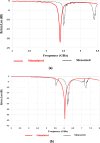A compact dual-band reconfigurable antenna with metamaterial for IoT applications
- PMID: 40595995
- PMCID: PMC12214684
- DOI: 10.1038/s41598-025-05174-y
A compact dual-band reconfigurable antenna with metamaterial for IoT applications
Abstract
This study presents a compact antenna designed for Internet of Things (IoT) applications, utilizing advanced wireless communication technologies. The antenna is designed to operate at dual frequencies (2.4 GHz and 6.04 GHz) with 12 multipath T-structured metamaterials. In Mode 1 (D1 OFF), the antenna operates at 2.4 GHz with a bandwidth of 80 MHz (2.36-2.44 GHz). In Mode 2 (D1 ON), it functions at 6.04 GHz with a bandwidth of 300 MHz (5.9-6.2 GHz). The design employs a commercially available FR-4 substrate with a relative permittivity of 4.3 and a loss tangent of 0.025, all within a compact size of (0.16λ₀ × 0.12λ₀ × 0.0112λ₀). The antenna radiator integrates a single PIN diode (SMP1340-079LF) along with a complete biasing circuit to achieve reconfigurability. The proposed design overcomes the conventional limitations by integrating T-structured metamaterials to achieve dual-band operation in a compact size. This antenna is ideal for wireless communication applications due to its manufacturability, enhanced gain, and low return loss. It is well suited for widely used frequency ranges, including Wi-Fi and Bluetooth. The results demonstrate that a miniaturized antenna with excellent efficiency has achieved, making it a promising solution for next-generation IoT devices.
Keywords: Dual-band; Internet of Things; Metamaterial; Positive intrinsic negative diode; Reconfigurable; Unit cell.
© 2025. The Author(s).
Conflict of interest statement
Declarations. Competing interests: The authors declare no competing interests.
Figures










References
-
- Islam, M. S. et al. A modified meander line microstrip patch antenna with enhanced bandwidth for 2.4 GHz ISM-band Internet of Things (IoT) applications. IEEE Access7, 127850–127861 (2019).
-
- Azim, R., Islam, M. T. & Mobashsher, A. T. Design of a dual band-notch UWB slot antenna by means of simple parasitic slits. IEEE Antennas Wirel. Propag. Lett.12, 1412–1415 (2013).
-
- Abd, A. K. & Rasool, J. M. Octa-band reconfigurable monopole antenna frequency diversity 5G wireless. Int. J. Electr. Comput. Eng.13(2), 1606–1617 (2023).
-
- Colaco, J. & Lohani, R. Design and implementation of microstrip circular patch antenna for 5G applications. In 2020 International Conference on Electrical, Communication, and Computer Engineering (ICECCE) 1–4. (IEEE, 2020).
-
- Sharma, B. L., Mathur, D. & Sharma, M. K. SIW-cavity based frequency reconfigurable antenna for IoT, WLAN, and 5G applications. Frequenz77(7–8), 413–424 (2023).
Grants and funding
LinkOut - more resources
Full Text Sources
Miscellaneous

